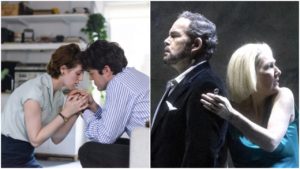
Opera Meets Film: How Life & Art Are Intertwined in ‘The Souvenir’s’ Use of ‘Bluebeard’s Castle’
By David Salazar“Opera Meets Film” is a feature dedicated to exploring the way that opera has been employed in cinema. We will select a section or a film in its entirety, highlighting the impact that utilizing the operatic form or sections from an opera can alter our perception of a film that we are viewing. This week’s installment looks at Joanna Hogg’s “The Souvenir.”
“The Souvenir” centers on the relationship between a burgeoning filmmaker Julie and her heroine-addict boyfriend Anthony, the latter’s addiction slowly damaging a relationship that opens in promising manner. This experience is explored through one particular piece of music – “Bluebeard’s Castle” by Bartók.
Hogg has noted that this film is autobiographical in nature and that the inclusion of the opera is linked to the person on whom Anthony is based.
“From the beginning, when I was writing the film. ‘Bluebeard’s Castle [the opera by Béla Bartók]’ was the first piece of music that I knew I wanted to use, because it connects to the original person that Anthony is based on—it was his favorite opera, and I listened to it a lot at that time,” Hogg noted in an interview with Slate. She also added that she didn’t want the music to guide the emotions, but to instead appear at surprising moments that one would not expect.
And there is no doubt that she achieves this effect throughout. The first time we hear the opera, Julie is entering her apartment to find Anthony there for the first time. The ominous music of the Bartók opera resounds, creating an unsettling sense of foreboding; Anthony is now in Julie’s space and the audience, almost by instinct, senses that this is not necessarily a good thing for Julie.
The opera then reappears once more during their first sex scene, a wide shot framed from afar initially that keeps the viewer far from the intimacy of the act. This will be contrasted with a latter love scene, filmed with tight angles, but this time in the darkness of night; the score appears here as well, undercutting any potential romance one might associate with the act between these characters.
Time and again, the return of the opera seems to suggest and spell doom for the relationship. It starts to appear more and more readily as the tension ramps up between the two eventually disappearing once Julie ends her relationship with Anthony.
As the film unfolds with the increased presence of “Bluebeard’s Castle,” one might associate the toxic underpinnings of the relationship with Anthony’s addition. After all, the opera itself is about a man who murders all of his wives and is in the process of likely doing the same to his latest, unsuspecting bride Judith. Judith has no suspicions of Bluebeard’s toxic nature, similar to Julie’s own ignorance of her boyfriend’s addiction for nearly half the film. In this context, one could easily interpret the music as hinting both at Judith and Julie’s tragedy in a continued relationship with a questionable male.
But the film actually draws us in a different direction that highlights the ambiguity of the opera’s own intensity. The foreshadowing of the music isn’t necessarily a condemnation of Anthony as a person, but is ultimately a characterization of his addiction and its damaging effect; at first, we sense it even when we don’t know exactly what it is. Still, it hangs like a dark cloud over their relationship. But as we get to realize the core of the conflict and the emotional challenges faced by Anthony and Julie, we start to feel that the film, through the music, is not relieving Anthony of his responsibility, but it also isn’t judging him for the addiction.
This is further amplified in another scene that also includes another operatic excerpt. After Anthony has ransacked Julie’s apartment, presumably related to his addiction. The two then run off to Venice where Julie breaks down in their hotel room. As Anthony tries to connect with her, we hear a mournful tune outside the window, interpreted by a street performer. The music in question – the overture from “La Forza del Destino,” specifically the main theme from Alvaro and Carlo’s final duet in which the form asks the latter for mercy.
The piece itself suggests that this scene, the very first of tension and conflict between the two, is fated to happen again and again until the relationship is finished. But instead of using the ominous nature of Bartók’s music for this scene of conflict and thus adding to it, Hogg does what she states in the interview – she uses something unexpected; she uses a theme that begs for clemency. She uses a theme that mourns and strives for something better, softening the moment and even amplifying the fact that Anthony is the only one we can see visibly and clearly in the frame throughout the exchange (Julie is off-screen and seen in a distant mirror).
What is likely most fascinating about the ultimate use of the Bartók opera in this film is that the choice was inspired by life itself. It wasn’t a case of a director having a story and then seeking out a piece that would dovetail thematically with her story, even if it was not necessarily related directly. In this case, the music was a living part of the story. As Hogg notes in her interview, “she listened to it a lot at the time.”
But as fate would have it, in the context of the film, Bartók’s score ultimately informs the real-life story far beyond the initial impact it might have had in real life. It personifies the story in a number of ways, potentially recontextualizing the Julie-Anthony relationship in the context of Bluebeard and Judith’s. Life often imitates art, but in this case, art is also life and life is art.
Categories
Opera Meets Film

